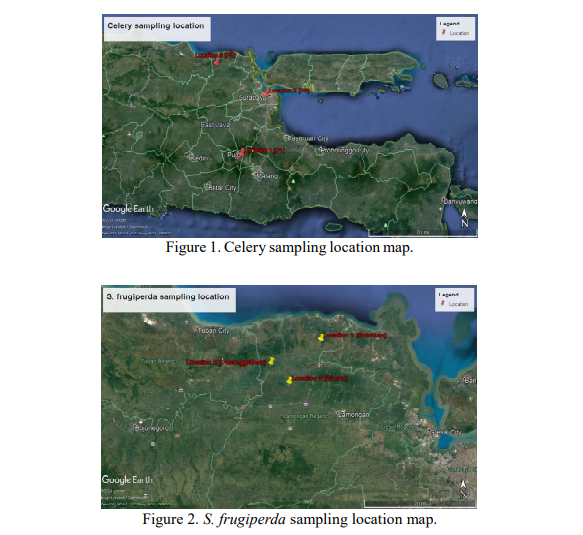REPELLENCY OF CELERY ESSENTIAL OILS (Apium graveolens L.) AGAINST Spodoptera frugiperda (Lepidoptera: Noctuidae) IN THE LABORATORY
Main Article Content
Abstract
Repellency of celery essential oil (Apium graveolens L.) against Spodoptera frugiperda (Lepidoptera: Noctuidae) in the laboratory. Essential oil is one of the ingredients that has repellent ability to herbivorous insects. Celery is one of plants containing essential oil which may also have the repellent ability. This study was aimed to determine the differences in the repellent ability of celery essential oils compounds that were taken from 3 different locations against S. frugiperda in the laboratory. This research was arranged in a factorial completely randomized design (CRD) with two factors. The first factor was the origin of the celery plants (Malang, Surabaya, and Lamongan) and the second factor was the concentration level of essential oils (1000, 2000, and 3000 ppm) which was repeated three times. The reliability test was carried out using filter paper method. The results showed that the essential oil extracted from celery originated from Malang with 3000 ppm concentration had the highest percentage level of repellency (level 5) that reached 93.33% of repellency. Location and concentration factors had no different effect on S. frugiperda larvae repellency. There was no correlation between location and concentration on the repellency of S. frugiperda larvae.
Article Details

This work is licensed under a Creative Commons Attribution-NonCommercial 4.0 International License.
References
Akuba J, Thomas N, & Palay RDJ. 2019. Efek ekstrak metanol daun seledri (Apium graveolens Linn.) sebagai insektisida terhadap nyamuk. JSSCR. 1(1): 1–7.
Al-Asmari AK, Athar MdT, & Kadasah SG. 2017. An updated phytopharmacological review on medicinal plant of Arab Region: Apium graveolens Linn. Pharmacogn Rev. 11(21): 13–18.
Asmaliyah, Hadi EEW, Utami S, Mulyadi K, Yudhistira, & Sari FW. 2010. Introduction of Vegetable Pesticide Producing Plants and their Traditional Use. Pusat Litbang Produktivitas Hutan. Palembang.
Astuti E, Sunarminingsih R, Jenie UA, Mubarika S, & Sismindari. 2014. Pengaruh lokasi tumbuh, umur tanaman dan variasi jenis destilasi terhadap komposisi senyawa minyak atsiri rimpang Curcuma mangga produksi beberapa sentra di Yogyakarta. J. Manusia dan Lingkungan. 21(3): 323–330.
Astuti RD & Khotimah S. 2020. Patch formulation of celery leaves extract (Apium Graveolens L.) as mosquito repellent. Advances in Social Science, Education and Humanities Research. 521: 83–87.
Azkiyah DR & Tohari. 2019. Effect of altitude on growth, yield and steviol glycosides content of stevia plant (Stevia rebaudiana). Vegetalika. 8(1): 1–12.
Balfas R & Sugandi E. 2013. Effect of vegetable oil on Aspidiella hartii infestation on ginger. In: Otih R, Agus W, Nurliani B, Dono W, Supriadi, Laba IW, Rodiah B, Muhammad D, Hoerudin, Kannan S, Anandaraj M, Oriel FDL, & Bui CB (Eds.). Prosiding Seminar Inovasi Tanaman Atsiri. pp. 86–96. Indonesian Agency for Agricultural Research and Development (IAARD), Solok.
Balfas R, Willis M, & Sugandi E. 2013. Potential of botanical insecticides for controlling rhizome fly (Mimegralla coeruleifrons Macquart) on ginger. In: Otih R, Agus W, Nurliani B, Dono W, Supriadi, Laba IW, Rodiah B, Muhammad D, Hoerudin, Kannan S, Anandaraj M, Oriel FDL, & Bui CB (Eds.). Proceedings of the International Seminar on Spices, Medicinal, and Aromatic Plants (SMAPs). pp. 153–157. Indonesian Agency for Agricultural Research and Development (IAARD), Jakarta.
Cameron RR, Arinafril, & Mulawarman. 2016. Uji bioaktivitas ekstrak daun zodea (Evodia suaveolens Sheff) terhadap hama gudang Tribolium castaneum (Coleoptera: Tenebrionidae) Herbst. E-Jurnal Agroekoteknologi Tropika. 5(3): 222–231.
Darmiati NN. 2013. Uji aktivitas ekstrak daun seledri (Apium graveolens L.) terhadap kumbang kacang Callosobruchus chinensis L. (Coleoptera: Bruchidae). Agrotop. 3(1): 17–22.
FAO. 2019. Indonesia Prepares for Battle with Fall Armyworm. http://www.fao.org/indonesia/news/detail-events/en/c/1202177/. Accessed on November 2020.
Ginting S, Nadrawati, Zarkani A, & Sumarni T. 2020. Natural incidence of entomopathogenic fungus Nomuraea rileyi on Spodoptera frugiperda infesting corn in Bengkulu. J. HPT Tropika. 20(2): 85–91.
Hasyim A, Setiawati W, Jayanti H, & Krestini EH. 2014. Repellency of essential oils against of shallot stored insect Ephestia cautella (Walker) (Lepidoptera: Pyrallidae) under laboratory condition. J. Hort. 24(4): 336–345.
Luik A, Ochsner P, & Jensen TS. 1999. Olfactory responsees of seed wasps Megastigmus pinus Parfitt and Megastigmus rafni Hoffmeyer (Hym., Torymidae) to host-tree odours and some monoterpenes. J. Appl. Entomol. 123(9): 561–567.
Kooti W & Daraei N. 2017. A review of the antioxidant activity of celery (Apium graveolens L). J. Evid. Based Complementary Altern. Med. 22(4): 1029–1034.
Maharani Y, Dewi VK, Puspasari LT, Rizkie L, Hidayat Y, & Dono D. 2019. Cases of fall army worm Spodoptera frugiperda J. E. Smith (Lepidoptera: Noctuidae) attack on maize in Bandung, Garut and Sumedang District, West Java. J. Cropsaver. 2(1): 38–46.
Rohimatun & Laba IW. 2013. Efektivitas insektisida minyak serai wangi dan cengkeh terhadap hama pengisap buah lada (Dasynus piperis China). Bul. Littro. 24(1): 26–34.
Rozek E, Nurzyñska-Wierdak R, Salata A, & Gumiela P. 2016. The chemical composition of the essential oil of leaf celery (Apium graveolens L. Var. Secalinum Alef.) under the plants’ irrigation and harvesting method. Acta Sci. Pol. Hortorum Cultus. 15(1): 149–159.
Sari M, Lubis L, & Pangestiningsih Y. 2013. Uji efektivitas beberapa insektisida nabati untuk mengendalikan ulat grayak (Spodoptera litura F.) (Lepidoptera: Noctuidae) di laboratorium. J. Online Agroekoteknologi. 1(3): 560–569.
Tripathi AK, Upadhyay S, Bhuiyan M, & Bhattacharya PR. 2009. A review on prospects of essential oils as biopesticide in insect-pest management. J. Pharmacogn. Phytotherapy. 1(5): 52–63.
Trisyono YA, Suputa, Aryuwandari VEF, Hartaman M, & Jumari. 2019. Occurrence of heavy infestation by the fall armyworm Spodoptera frugiperda, a new alien invasive pest, in corn in Lampung Indonesia. JPTI. 23(1): 156–160.
Tuetun B, Choochote W, Rattanachanpichai E, Chaithong U, Chaiwong P, Jitpakdi A, Tippawangkosol P, Riyong D, & Pitasawat B. 2005. Repellent properties of celery, Apium graveolens L., compared with commercial repellents, against mosquitoes under laboratory and field conditions. Trop. Med. Int. Health. 10(11): 1190–1198.

